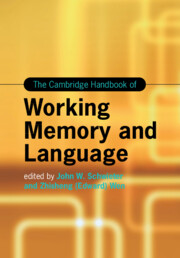Book contents
- The Cambridge Handbook of Working Memory and Language
- Cambridge Handbooks in Language and Linguistics
- The Cambridge Handbook of Working Memory and Language
- Copyright page
- Contents
- Figures
- Tables
- About the Editors
- About the Contributors
- Acknowledgments
- Overview of the Handbook
- Part I Introduction
- Part II Models and Measures
- Part III Linguistic Theories and Frameworks
- Part IV First Language Processing
- Part V Bilingual Acquisition and Processing
- 24 How Measures of Working Memory Relate to L2 Vocabulary
- 25 Working Memory and L2 Grammar Development in Children
- 26 Working Memory and L2 Grammar Learning among Adults
- 27 Working Memory and L2 Sentence Processing
- 28 Methodological Issues in Research on Working Memory and L2 Reading Comprehension
- 29 Working Memory and Second Language Speaking Tasks
- 30 Working Memory in Second Language Interaction
- 31 Working Memory and Interpreting Studies
- 32 A Methodological Synthesis of Working Memory Tasks in L2 Research
- Part VI Language Disorders, Interventions, and Instruction
- Part VII Conclusion
- Index
- References
25 - Working Memory and L2 Grammar Development in Children
from Part V - Bilingual Acquisition and Processing
Published online by Cambridge University Press: 08 July 2022
- The Cambridge Handbook of Working Memory and Language
- Cambridge Handbooks in Language and Linguistics
- The Cambridge Handbook of Working Memory and Language
- Copyright page
- Contents
- Figures
- Tables
- About the Editors
- About the Contributors
- Acknowledgments
- Overview of the Handbook
- Part I Introduction
- Part II Models and Measures
- Part III Linguistic Theories and Frameworks
- Part IV First Language Processing
- Part V Bilingual Acquisition and Processing
- 24 How Measures of Working Memory Relate to L2 Vocabulary
- 25 Working Memory and L2 Grammar Development in Children
- 26 Working Memory and L2 Grammar Learning among Adults
- 27 Working Memory and L2 Sentence Processing
- 28 Methodological Issues in Research on Working Memory and L2 Reading Comprehension
- 29 Working Memory and Second Language Speaking Tasks
- 30 Working Memory in Second Language Interaction
- 31 Working Memory and Interpreting Studies
- 32 A Methodological Synthesis of Working Memory Tasks in L2 Research
- Part VI Language Disorders, Interventions, and Instruction
- Part VII Conclusion
- Index
- References
Summary
The role of working memory in language learning has received considerable attention, but several pertinent issues remain. One of these concerns the directionality of the relationships between working memory and language learning. Another issue relates to different types of processing and working memory components involved in learning different aspects of a second language (vocabulary, grammatical sub-skills, e.g., subject-verb agreement, verb placement, word order, auxiliaries). In this chapter we review and integrate findings of previous studies, following the extraction and integration model (Thiessen et al., 2013), and apply these to second language learning. In so doing, we distinguish between statistical learning based on conditional relations of adjacencies (extraction) and statistical learning based on distributional patterns of non-adjacencies (integration). We propose how L2 children's gradual increase in knowledge of the second language increases the sensitivity of working memory to cues in ambient speech that, in turn, fosters further second language learning.
Information
- Type
- Chapter
- Information
- The Cambridge Handbook of Working Memory and Language , pp. 550 - 572Publisher: Cambridge University PressPrint publication year: 2022
